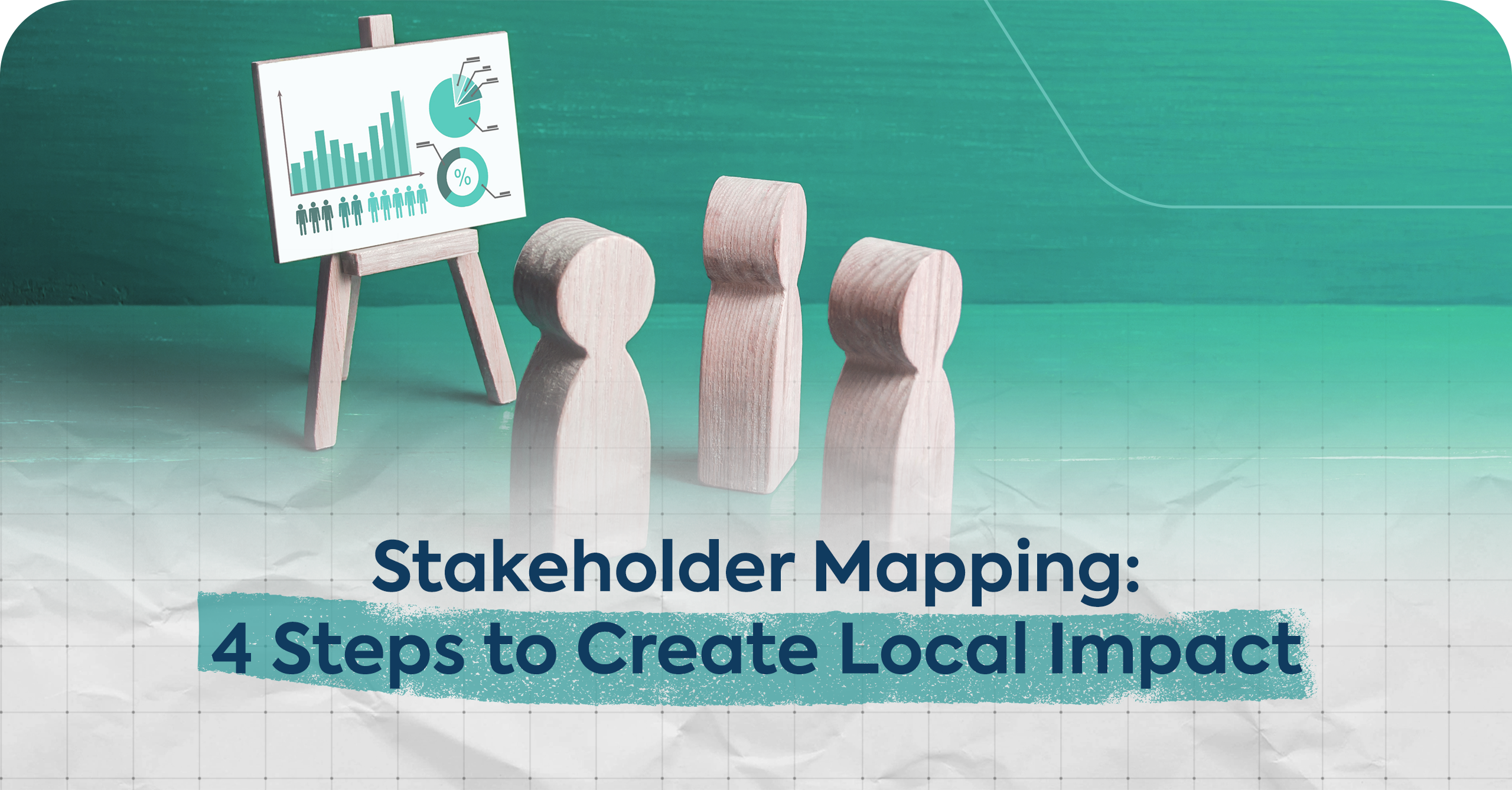Social value delivery works best when it’s focused. Focused on people, on place, and on the issues that matter most to local communities.
Yet, many projects begin with vague ambitions and broad social value themes like employability, wellbeing, or sustainability. And for a good reason – with organisations in vastly different stages in their social value journey, with sometimes challenging levels of resource, these themes serve as a useful guide to what is possible, and a good indicator of your values. While these values are important, real impact depends on knowing exactly who you’re helping and how you can help them. That’s why stakeholder mapping should be your starting point.
In this blog, we’ll walk you through a four-step process for creating a highly effective stakeholder map, along with a free stakeholder mapping template to guide your next project. This method works whether you’re a in procurement, community regeneration, social value delivery, or project management.
What Is Stakeholder Mapping and Why Is It Important?
Stakeholder mapping is a process that helps you identify, understand, and prioritise the people, communities, and organisations affected by your project. It allows you to plan your social value strategy based on real community needs, rather than generic KPIs or assumptions.
Done well, stakeholder mapping becomes a foundation for:
- Measurable outcomes
- Improved engagement
- Transparent reporting
- Long-term community impact
Local authorities like Blackpool Council use stakeholder mapping techniques to embed relevance and accountability into public sector contracts. Their approach is guided by data, lived experience, and collaboration, all key principles outlined in resources such as HM Treasury’s Green Book and the ONS’s area profiles.
Aimi O’Donnell, Social Value Manager, Blackpool Council shared more about their approach to social value, from writing bids, to setting and measuring social value targets.
“Our approach at Blackpool Council supports suppliers in creating targeted, measurable social value plans aligned with Blackpool’s priorities. This ensures social value is embedded in contracts and delivers real, tangible benefits like jobs, skills, and community wellbeing.
We encourage suppliers to focus on capturing the difference made through genuine stories and evidence, highlighting the human impact behind the outcomes. We don’t request case studies just for the sake of them — we actively learn from these stories to help the Council and stakeholders understand what’s working and where improvements or changes are needed. This insight drives continuous improvement and helps us build a lasting, positive legacy—not just for today, but for future generations.”
If you want to move beyond tick-box exercises and build strategies that make a measurable difference, this process is where you begin.
Step 1: Identify Priority Areas for Your Stakeholder Map
Start by defining the geographic focus of your stakeholder map. Which places are most affected by deprivation, and where could your project make the biggest difference?
Use data sources such as:
- The Index of Multiple Deprivation (IMD) — showing detailed statistics across health, education, crime, housing, and income
- Local demographic profiles — identifying whether you’re working with ageing populations, young families, or ethnically diverse communities
- Maps and planning data — revealing barriers like lack of public transport, green space, or community services
For example, in a northern post-industrial town with high unemployment and low skill levels, you might prioritise youth employability and digital skills development.
By anchoring your project in evidence, your stakeholder map becomes more than a visual, it becomes a strategic targeting tool.
Step 2: Use Stakeholder Mapping to Identify Local Issues and Priorities
Now that you’ve defined the area, the next part of your stakeholder mapping process is understanding what local people care about most. This helps you move from broad themes to community-led outcomes.
Consider tapping into intelligence sources such as:
- Local Authority priorities – understand the mission, check for existing social value, housing, health, and environmental objectives
- MP newsletters, local news, and community consultations – for real-time insight into what’s top of mind locally
- Community group social media pages – offering anecdotal and grassroots-level intelligence
- Geographic context – for example, coastal towns may struggle with seasonal employment while rural communities might lack access to services
For example, if your stakeholder map shows a predominance of older adults in a rural setting, you might focus your project on tackling loneliness and accessibility through community transport or befriending services.
By using local intelligence alongside hard data, your stakeholder mapping exercise becomes both strategic and empathetic.
Step 3: Match Your Stakeholder Mapping Insights to Deliverable Outcomes
With the issues and opportunities now identified, think about what your organisation is best placed to do and how you can contribute meaningfully within your scope, resources, and timeframe.
Ask yourself:
- What types of social value add (e.g., employment, skills, donations, mentoring, infrastructure) can we realistically provide?
- Do we have a local supply chain, staff, or community access that others don’t?
- What outcomes can be measured and sustained within the project’s timescale?
Narrow your plan to three or four themes where your project can make a meaningful impact. These are the focus points your stakeholder mapping tool should be centred around.
For example, a contractor refurbishing council housing may include apprenticeships for local unemployed residents and partner with a local college for training delivery.
By identifying what you’re best placed to do, your stakeholder map shifts from insight to action.
Step 4: Populate Your Stakeholder Map Template with Local Partners
Finally, stakeholder mapping is incomplete without understanding who else is already active in your area. Community organisations, charities, and local services will likely already have trust and knowledge within the area. Working with them adds value and legitimacy to your project.
Use your stakeholder map template to research and record:
- Local charities and social enterprises
- Schools, colleges, and training providers
- Community centres, churches, and volunteer groups
- Environmentally focused groups aligned with net zero or nature-based priorities
For example, if your project focuses on mental health, partner with an established community group that delivers peer support or therapy workshops.
Download Your Free Stakeholder Mapping Template (PDF)
To help you get started, we’ve created a free stakeholder mapping template that follows the four-step method outlined above. It’s designed for use in public sector procurement, bid development, social value strategy, or community planning.
Click here to download your free stakeholder mapping template.
Use it during early planning stages or to structure meetings with contractors, suppliers, councillors or even community partners. Stakeholder mapping is more than a project tool—it’s a mindset. One that puts people and place first. The most successful social value initiatives start not with generic promises, but with clear insights and strong relationships. Your stakeholder map is where that begins. So don’t just guess what your community needs. Map it. And build something that lasts. For more information on stakeholder mapping, or social value in general – don’t hesitate to reach out to our Social Value Advisor, Jack Neath at jack@procurepartnerships.co.uk



